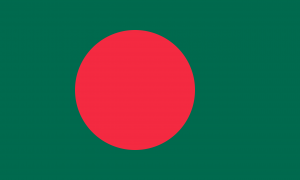Language/Bengali/Vocabulary/Clothes
Hi Bengali learners! 😊
In this lesson, we will learn about clothes in Bengali. Clothes are an important part of any culture, and learning about them will help you better understand the Bengali culture. This lesson is aimed at intermediate learners, so it is assumed that you already know the basics of Bengali grammar and vocabulary. If you need to brush up on your skills, be sure to check out the Bengali Vocabulary section. Also, don't forget to practice with native speakers on Polyglot Club and ask them any questions you may have!
Types of Clothes[edit | edit source]
Bengali people love to wear bright and colorful clothes. Here are some of the most popular types of clothes you will find in Bengali culture:
| Bengali | Pronunciation | English |
|---|---|---|
| শাড়ি (shari) | IPA: /ʃaːɽi/ | Sari |
| পাঞ্জাবি (panjabi) | IPA: /paⁿd͡ʒaːbi/ | Kurta |
| পাঞ্জাবিশার্ট (panjabishart) | IPA: /paⁿd͡ʒaːbiʃaːɾt/ | Kurta shirt |
| পাঞ্জাবিপায়জামা (panjabipayjama) | IPA: /paⁿd͡ʒaːbipajd͡ʒaːma/ | Kurta pajama |
| পায়জামা (payjama) | IPA: /pajd͡ʒaːma/ | Pajama |
| ঘাঘরা (ghagara) | IPA: /ɡʱaɡʰɑɾa/ | Lehenga |
| সালোয়ার কামিজ (shaloar kamij) | IPA: /ʃalɔaɾ kæmid͡ʒ/ | Salwar Kameez |
| ফুটো (foto) | IPA: /futo/ | Skirt |
| দুতি (duti) | IPA: /d̪uːt̪i/ | Dhoti |
| পায়জামাকামিজ (payjama kamij) | IPA: /pajd͡ʒaːma kaːmid͡ʒ/ | Pajama Kurta |
Conversational Examples[edit | edit source]
Here are some examples of how you can use these words in a conversation:
- Person 1: তুমি কি পাঞ্জাবি পরো? (Tumi ki panjabi poro?) (Do you wear a kurta?)
- Person 2: হ্যাঁ, আমি পাঞ্জাবি পরি। (Hyām, āmi panjabi pori.) (Yes, I wear a kurta.)
- Person 1: তুমি শাড়ি পরো না? (Tumi shari poro na?) (Don't you wear a sari?)
- Person 2: না, আমি শাড়ি পরিনা। (Na, āmi shari porina.) (No, I don't wear a sari.)
- Person 1: দুতি কি তোমার লাগে? (Duti ki tomar lage?) (Do you like wearing dhoti?)
- Person 2: না, আমি দুতি পরিনা। (Na, āmi duti porina.) (No, I don't wear dhoti.)
Colors[edit | edit source]
Colors are very important in Bengali culture, and clothes are often chosen based on their colors. Here are some basic colors you should know:
| Bengali | Pronunciation | English |
|---|---|---|
| লাল (lal) | IPA: /lal/ | Red |
| হলুদ (holud) | IPA: /holud/ | Yellow |
| সবুজ (shobuj) | IPA: /ʃobud͡ʒ/ | Green |
| নীল (nil) | IPA: /nil/ | Blue |
| কালো (kalo) | IPA: /kalɔ/ | Black |
| ধূসর (dhusor) | IPA: /d̪ʱuʂɔr/ | Grey |
Conversational Examples[edit | edit source]
Here are some examples of how you can use colors in a conversation:
- Person 1: তোমার পাঞ্জাবি সবুজ কিন্তু আমার হলুদ। (Tomar panjabi shobuj kintu amar holud.) (Your kurta is green but mine is yellow.)
- Person 2: হ্যাঁ, আমার পছন্দ সবুজ। (Hyām, amar pochondo shobuj.) (Yes, I like green.)
- Person 1: তোমার সালোয়ারকামিজ দেখতে লাল। (Tomar salwar kameez dekhte lal.) (Your salwar kameez looks red.)
- Person 2: না, আমার সালোয়ারকামিজ হলুদ। (Na, amar salwar kameez holud.) (No, my salwar kameez is yellow.)
Conclusion[edit | edit source]
Congratulations, you have learned about clothes and colors in Bengali culture! Remember, the best way to improve your language skills is to practice with native speakers. Use Polyglot Club to find native speakers to practice with online. If you have any questions, please ask them in the comments section below.
➡ Feel free to edit this wiki page if you think it can be improved. 😎
With this lesson finished, you may want to explore these additional pages: Count to 10, Drinks, How to say Good Bye? & Airport.
Other Lessons[edit | edit source]
- Family
- Fruits
- How to say Good Bye?
- How to Say Hello and Greetings
- Geography
- Useful phrases
- Days of the Week
- Count to 10
- Months of the year
- Greetings
Sources[edit | edit source]
- Clothes in Bengali | Pinhok Languages
- clothes meaning in Bengali | clothes translation in Bengali ...

